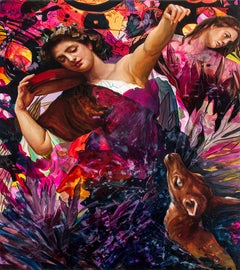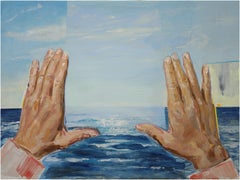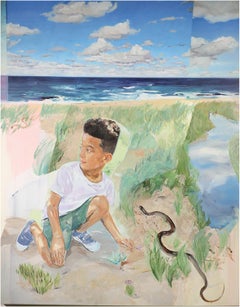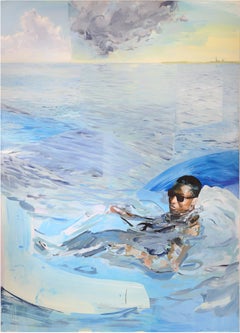Hirschl & Adler Figurative Paintings
to
33
1
1
22
11
5
9
3
5
11
Overall Height
to
Overall Width
to
16
1
1
31
22
9
7
7
5
4
3
3
3
3
3
2
2
2
2
1
1
1
1
6
4
23
15
2
1
1
1
33
31
28
20
8
The Circle is Cast, We Are Between the Worlds
By Angela Fraleigh
Located in New York, NY
In Angela Fraleigh’s dynamic paintings, female subjects culled from art history become active protagonists in newly imagined spaces. In their original contexts, these figures were la...
Category
2010s Figurative Paintings
Materials
Oil, Acrylic
I Shall Not Die but Live II
Located in New York, NY
Oil on canvas, 2023
Category
2010s Figurative Paintings
Materials
Canvas, Oil
They Surrounded Me on Every Side
Located in New York, NY
Oil on canvas, 2023
Category
2010s Figurative Paintings
Materials
Canvas, Oil
They Surrounded Me Like Bees
Located in New York, NY
Oil on canvas, 2023
Category
2010s Figurative Paintings
Materials
Canvas, Oil
I Shall Not Die but Live I
Located in New York, NY
Oil on canvas, 2023
Category
2010s Figurative Paintings
Materials
Canvas, Oil
Into a Spacious Place
Located in New York, NY
Oil on canvas, 2023
Category
2010s Figurative Paintings
Materials
Canvas, Oil
Star
Located in New York, NY
Oil on canvas, 2023
Category
2010s Figurative Paintings
Materials
Canvas, Oil
I Cut Them Down
Located in New York, NY
Oil on canvas, 2023
Category
2010s Figurative Paintings
Materials
Canvas, Oil
Jardin des Tuileries, Paris
By Edmund Quincy
Located in New York, NY
Signed (lower right): Quincy
Category
20th Century American Realist Figurative Paintings
Materials
Canvas, Oil
Japanese Children with Tortoise
By Harry Humphrey Moore
Located in New York, NY
Harry Humphrey Moore led a cosmopolitan lifestyle, dividing his time between Europe, New York City, and California. This globe-trotting painter was also active in Morocco, and most importantly, he was among the first generation of American artists to live and work in Japan, where he depicted temples, tombs, gardens, merchants, children, and Geisha girls. Praised by fellow painters such as Thomas Eakins, John Singer Sargent, and Jean-Léon Gérôme, Moore’s fame was attributed to his exotic subject matter, as well as to the “brilliant coloring, delicate brush work [sic] and the always present depth of feeling” that characterized his work (Eugene A. Hajdel, Harry H. Moore, American 19th Century: Collection of Information on Harry Humphrey Moore, 19th Century Artist, Based on His Scrap Book and Other Data [Jersey City, New Jersey: privately published, 1950], p. 8).
Born in New York City, Moore was the son of Captain George Humphrey, an affluent shipbuilder, and a descendant of the English painter, Ozias Humphrey (1742–1810). He became deaf at age three, and later went to special schools where he learned lip-reading and sign language. After developing an interest in art as a young boy, Moore studied painting with the portraitist Samuel Waugh in Philadelphia, where he met and became friendly with Eakins. He also received instruction from the painter Louis Bail in New Haven, Connecticut. In 1864, Moore attended classes at the Mark Hopkins Institute in San Francisco, and until 1907, he would visit the “City by the Bay” regularly.
In 1865, Moore went to Europe, spending time in Munich before traveling to Paris, where, in October 1866, he resumed his formal training in Gérôme’s atelier, drawing inspiration from his teacher’s emphasis on authentic detail and his taste for picturesque genre subjects. There, Moore worked alongside Eakins, who had mastered sign language in order to communicate with his friend. In March 1867, Moore enrolled at the prestigious École des Beaux-Arts, honing his drawing skills under the tutelage of Adolphe...
Category
Late 19th Century Figurative Paintings
Materials
Oil, Wood Panel
The Gateway
By Eleanor Parke Custis
Located in New York, NY
Signed (lower right): ELEANOR PARKE CUSTIS
Category
20th Century American Realist Landscape Paintings
Materials
Paper, Gouache
The Stars Rise, the Moon Bends Her Arc
By Angela Fraleigh
Located in New York, NY
Signed and dated (on verso): Angela Fraleigh 2021
Category
2010s Contemporary Figurative Paintings
Materials
Linen, Oil
Stars Splinter, Pointed and Wild
By Angela Fraleigh
Located in New York, NY
Unsigned
Category
2010s Contemporary Portrait Paintings
Materials
Linen, Oil
In an Absent Dream
By Angela Fraleigh
Located in New York, NY
Unsigned
Category
2010s Contemporary Portrait Paintings
Materials
Canvas, Charcoal, Oil
A Word For What Binds
By Angela Fraleigh
Located in New York, NY
Unsigned
Category
2010s Contemporary Portrait Paintings
Materials
Canvas, Charcoal, Oil
Splinters of a Secret Sky - Splinters
By Angela Fraleigh
Located in New York, NY
Signed (on verso): AF/2021
Category
2010s Contemporary Portrait Paintings
Materials
Canvas, Acrylic Polymer, Oil, Acrylic
Japanese Girl Promenading
By Harry Humphrey Moore
Located in New York, NY
Harry Humphrey Moore led a cosmopolitan lifestyle, dividing his time between Europe, New York City, and California. This globe-trotting painter was also active in Morocco, and most importantly, he was among the first generation of American artists to live and work in Japan, where he depicted temples, tombs, gardens, merchants, children, and Geisha girls. Praised by fellow painters such as Thomas Eakins, John Singer Sargent, and Jean-Léon Gérôme, Moore’s fame was attributed to his exotic subject matter, as well as to the “brilliant coloring, delicate brush work [sic] and the always present depth of feeling” that characterized his work (Eugene A. Hajdel, Harry H. Moore, American 19th Century: Collection of Information on Harry Humphrey Moore, 19th Century Artist, Based on His Scrap Book and Other Data [Jersey City, New Jersey: privately published, 1950], p. 8).
Born in New York City, Moore was the son of Captain George Humphrey, an affluent shipbuilder, and a descendant of the English painter, Ozias Humphrey (1742–1810). He became deaf at age three, and later went to special schools where he learned lip-reading and sign language. After developing an interest in art as a young boy, Moore studied painting with the portraitist Samuel Waugh in Philadelphia, where he met and became friendly with Eakins. He also received instruction from the painter Louis Bail in New Haven, Connecticut. In 1864, Moore attended classes at the Mark Hopkins Institute in San Francisco, and until 1907, he would visit the “City by the Bay” regularly.
In 1865, Moore went to Europe, spending time in Munich before traveling to Paris, where, in October 1866, he resumed his formal training in Gérôme’s atelier, drawing inspiration from his teacher’s emphasis on authentic detail and his taste for picturesque genre subjects. There, Moore worked alongside Eakins, who had mastered sign language in order to communicate with his friend. In March 1867, Moore enrolled at the prestigious École des Beaux-Arts, honing his drawing skills under the tutelage of Adolphe Yvon, among other leading French painters.
In December 1869, Moore traveled around Spain with Eakins and the Philadelphia engraver, William Sartain. In 1870, he went to Madrid, where he met the Spanish painters Mariano Fortuny and Martin Rico y Ortega. When Eakins and Sartain returned to Paris, Moore remained in Spain, painting depictions of Moorish life in cities such as Segovia and Granada and fraternizing with upper-crust society. In 1872, he married Isabella de Cistue, the well-connected daughter of Colonel Cistue of Saragossa, who was related to the Queen of Spain. For the next two-and-a-half years, the couple lived in Morocco, where Moore painted portraits, interiors, and streetscapes, often accompanied by an armed guard (courtesy of the Grand Sharif) when painting outdoors. (For this aspect of Moore’s oeuvre, see Gerald M. Ackerman, American Orientalists [Courbevoie, France: ACR Édition, 1994], pp. 135–39.) In 1873, he went to Rome, spending two years studying with Fortuny, whose lively technique, bright palette, and penchant for small-format genre scenes made a lasting impression on him. By this point in his career, Moore had emerged as a “rapid workman” who could “finish a picture of given size and containing a given subject quicker than most painters whose style is more simple and less exacting” (New York Times, as quoted in Hajdel, p. 23).
In 1874, Moore settled in New York City, maintaining a studio on East 14th Street, where he would remain until 1880. During these years, he participated intermittently in the annuals of the National Academy of Design in New York and the Pennsylvania Academy of the Fine Arts in Philadelphia, exhibiting Moorish subjects and views of Spain. A well-known figure in Bay Area art circles, Moore had a one-man show at the Snow & May Gallery in San Francisco in 1877, and a solo exhibition at the Bohemian Club, also in San Francisco, in 1880. Indeed, Moore fraternized with many members of the city’s cultural elite, including Katherine Birdsall Johnson (1834–1893), a philanthropist and art collector who owned The Captive (current location unknown), one of his Orientalist subjects. (Johnson’s ownership of The Captive was reported in L. K., “A Popular Paris Artist,” New York Times, July 23, 1893.) According to one contemporary account, Johnson invited Moore and his wife to accompany her on a trip to Japan in 1880 and they readily accepted. (For Johnson’s connection to Moore’s visit to Japan, see Emma Willard and Her Pupils; or, Fifty Years of Troy Female Seminary [New York: Mrs. Russell Sage, 1898]. Johnson’s bond with the Moores was obviously strong, evidenced by the fact that she left them $25,000.00 in her will, which was published in the San Francisco Call on December 10, 1893.) That Moore would be receptive to making the arduous voyage across the Pacific is understandable in view of his penchant for foreign motifs. Having opened its doors to trade with the West in 1854, and in the wake of Japan’s presence at the Philadelphia Centennial Exposition of 1876, American artists were becoming increasingly fascinated by what one commentator referred to as that “ideal dreamland of the poet” (L. K., “A Popular Paris Artist”).
Moore, who was in Japan during 1880–81, became one of the first American artists to travel to the “land of the rising sun,” preceded only by the illustrator, William Heime, who went there in 1851 in conjunction with the Japanese expedition of Commodore Matthew C. Perry; Edward Kern, a topographical artist and explorer who mapped the Japanese coast in 1855; and the Boston landscapist, Winckleworth Allan Gay, a resident of Japan from 1877 to 1880. More specifically, as William H. Gerdts has pointed out, Moore was the “first American painter to seriously address the appearance and mores of the Japanese people” (William H. Gerdts, American Artists in Japan, 1859–1925, exhib. cat. [New York: Hollis Taggart Galleries, 1996], p. 5).
During his sojourn in Japan, Moore spent time in Tokyo, Yokohama, Kyoto, Nikko, and Osaka, carefully observing the local citizenry, their manners and mode of dress, and the country’s distinctive architecture. Working on easily portable panels, he created about sixty scenes of daily life, among them this sparkling portrayal of a young woman dressed in a traditional kimono and carrying a baby on her back, a paper parasol...
Category
Late 19th Century Figurative Paintings
Materials
Oil, Wood Panel
A late frost drifted back
By Angela Fraleigh
Located in New York, NY
Signed on back
Category
2010s Contemporary Figurative Paintings
Materials
Linen, Oil
Our story was a ghostly one
By Angela Fraleigh
Located in New York, NY
Signed on verso
Category
2010s Contemporary Figurative Paintings
Materials
Linen, Oil
Rooted in Constellations
By Angela Fraleigh
Located in New York, NY
Signed and dated (on verso): Angela Fraleigh 2021
Category
2010s Contemporary Figurative Paintings
Materials
Linen, Oil
Shaking to Sound the Silent Skies
By Angela Fraleigh
Located in New York, NY
Signed and dated (on verso): Angela Fraleigh 2021
Category
2010s Contemporary Figurative Paintings
Materials
Linen, Oil
Wait For Me There
By Angela Fraleigh
Located in New York, NY
Signed and dated (on verso): Angela Fraleigh 2021
Category
2010s Contemporary Figurative Paintings
Materials
Canvas, Oil, Panel
Tumbling into Light
By Angela Fraleigh
Located in New York, NY
Signed and dated (on verso): Angela Fraleigh 2021
Category
2010s Contemporary Figurative Paintings
Materials
Canvas, Oil, Panel
Silent Sparks
By Angela Fraleigh
Located in New York, NY
Signed and dated (on verso): Angela Fraleigh 2021
Category
2010s Contemporary Figurative Paintings
Materials
Canvas, Oil, Panel
From Sunset to Sunrise
By Angela Fraleigh
Located in New York, NY
Signed and dated (on verso): Angela Fraleigh 2021
Category
2010s Contemporary Figurative Paintings
Materials
Linen, Oil
A Pang of Vivid Light
By Angela Fraleigh
Located in New York, NY
Signed and dated (on verso): "Angela Fraleigh 2021"
Category
2010s Contemporary Figurative Paintings
Materials
Linen, Oil
One Afternoon in Tuscany
By Alan Feltus
Located in New York, NY
A contemporary figurative painter whose art is rooted in both the past and the present, Alan Feltus specializes in enigmatic depictions of women. Notable for their purity and simplic...
Category
20th Century Contemporary Figurative Paintings
Materials
Canvas, Alkyd
The Japanese Corner
By Elliott Daingerfield
Located in New York, NY
A child of the American South, Elliott Daingerfield was born in Harper’s Ferry, Virginia, and raised in Fayetteville, North Carolina, where his father, C...
Category
19th Century American Impressionist Interior Paintings
Materials
Canvas, Oil
Hug
By Louisa Chase
Located in New York, NY
Louisa Lizbeth Chase was born in 1951 to Benjamin and Wilda Stengel Chase in Panama City, Panama, where her father, a West Point graduate, was stationed. The family moved to Pennsylv...
Category
20th Century American Modern Abstract Paintings
Materials
Canvas, Oil
The Race
By William John Hennessy
Located in New York, NY
William John Hennessy was born in Ireland. He came to America in 1849 with his mother and brother a year after his father had fled their homeland after taking part in the unsuccessful Young Ireland Party uprising. The Hennessys settled in New York, and when young William came of age, he decided upon a career as an artist. At the age of fifteen, he enrolled at the National Academy of Design, where he learned to draw from the antique, and the following year he was granted admission to the Academy’s life-drawing class.
Hennessy first exhibited at the National Academy in 1857, starting a continuous run of appearances in their annuals that lasted until 1870, when he expatriated himself to Europe. During his time in America, Hennessy was principally known as a genre painter and prolific illustrator for such publications as Harper’s Weekly and a number of books, including illustrated works of William Cullen Bryant...
Category
19th Century American Realist Figurative Paintings
Materials
Canvas, Oil
Peek-a-Boo
By Seymour Joseph Guy
Located in New York, NY
In the latter half of the nineteenth century and into the first decade of the twentieth, New York City art aficionados could count on finding recent work of Seymour Joseph Guy hanging on the walls of the city’s major galleries. Primarily a genre artist, but also a portraitist, between 1859 and 1908 Guy showed more than seventy works at the National Academy of Design. From 1871 to 1903 he contributed over seventy times to exhibitions at the Century Club. From 1864 to 1887, he sent about forty pictures to the Brooklyn Art Association. A good number of these works were already privately owned; they served as advertisements for other pictures that were available for sale. Some pictures were shown multiple times in the same or different venues. Guy was as easy to find as his canvases were omnipresent. Though he lived at first in Brooklyn with his family and then in New Jersey, from 1863 to his death in 1910 he maintained a studio at the Artist’s Studio Building at 55 West 10th Street, a location that was, for much of that period, the center of the New York City art world.
Guy’s path to a successful career as an artist was by no means smooth or even likely. Born in Greenwich, England, he was orphaned at the age of nine. His early interest in art was discouraged by his legal guardian, who wanted a more settled trade for the young man. Only after the guardian also died was Guy free to pursue his intention of becoming an artist. The details of Guy’s early training in art are unclear. His first teacher is believed to have been Thomas Buttersworth...
Category
19th Century American Realist Figurative Paintings
Materials
Canvas, Oil
John F. Kennedy International Airport
By Marc Trujillo
Located in New York, NY
Every detail in Trujillo’s fast-paced, consumer-driven environments is the result of slow painting, of careful and keen observation, both analytic and synthetic. Trujillo depicts his...
Category
2010s Contemporary Interior Paintings
Materials
Oil, Panel
At the Spring
By Joshua Shaw
Located in New York, NY
Joshua Shaw was a farmer’s son, born in Billingborough, Lincolnshire, and orphaned at the age of seven. After a boyhood of privation, he tried a number of occupations, until he finally apprenticed to a sign painter and found his métier. Shaw went to Manchester to study art, and by 1802 was in Bath, painting landscapes. In that year he began to exhibit his work at the Royal Academy in London. Essentially self-taught, Shaw achieved an impressive level of competence and versatility, producing portraits, floral compositions, still lifes, landscapes, and, cattle pieces. Shaw continued to send works for exhibition at the Royal Academy, the British Institution, and the Suffolk Street Gallery, all in London, until 1841. (Although Shaw is regularly mentioned and frequently illustrated in a host of general books on American art history, as well as included in numerous historical survey exhibitions, the only monographic study of this artist is Miriam Carroll Woods, “Joshua Shaw [1776–1860]: A Study of the Artist and his Paintings” [M.A. thesis, University of California at Los Angeles, 1971]. Apart from short biographical sketches in various dictionaries and museum collection catalogues, the two most interesting references, both contemporary, are John Sartain’s personal recollections in The Reminiscences of a Very Old Man, 1808–1897 [1899; reprint 1969] and an article in Scientific American from August 7, 1869, “Joshua Shaw, Artist and Inventor.” The article quotes extensively from an autobiographical document in the possession of Shaw’s grandson that Shaw prepared for William Dunlap...
Category
19th Century American Realist Landscape Paintings
Materials
Canvas, Oil





